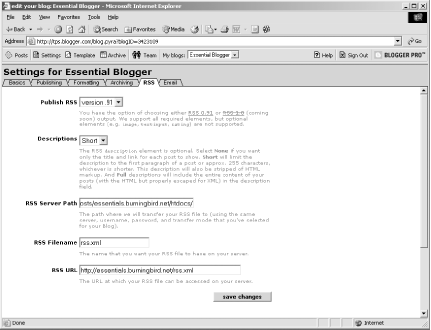Section 6.8. Adding Support for Syndication
Syndication gives your readers the ability to subscribe to an XML extraction of your blog information. This can be used within aggregation products such as Syndic8 (http://www.syndic8.com) or Radio UserLand.
Just as we finished writing this chapter, automatic support for RSS generation was added to Blogger Pro. The process does require that you use titles for your entries, but again, this is automatically supported with Blogger Pro. If you have access to Pro and self-host your blog (RSS isn't currently supported on BlogSpot), enable RSS generation by selecting the Settings view and clicking the RSS tab.
In the page that opens, turn RSS generation on by changing the entry in the dropdown box labeled Publish RSS from No to the version of RSS you wish. At this time, the only version supported is RSS .91. You can also choose whether a description is added for each entry in addition to the link and the title. You can choose a short description ? approximately 255 characters or the first paragraph ? or a full description (complete posting). We strongly recommend that you use the short description; long RSS entries play havoc with the usability of aggregation tools.
Finally, if you host your blog on your server, provide the RSS server path, RSS filename, and URL; these are most likely based on the same location as your blog page path. The RSS file for the Essential blog is named to rss.xml and is colocated with the blog page. Figure 6-19 shows the entries for this form.
Figure 6-19. Adding RSS support to the Essential Blogger blog

Once the changes are saved, publishing new blog postings or republishing the archives also publishes new entries to the RSS file.
All you need to do at this point is add a link to your template to point to your newly generated RSS file. This is usually labeled Subscribe, or marked by an orange button with XML in it, but you can use whatever you wish.






